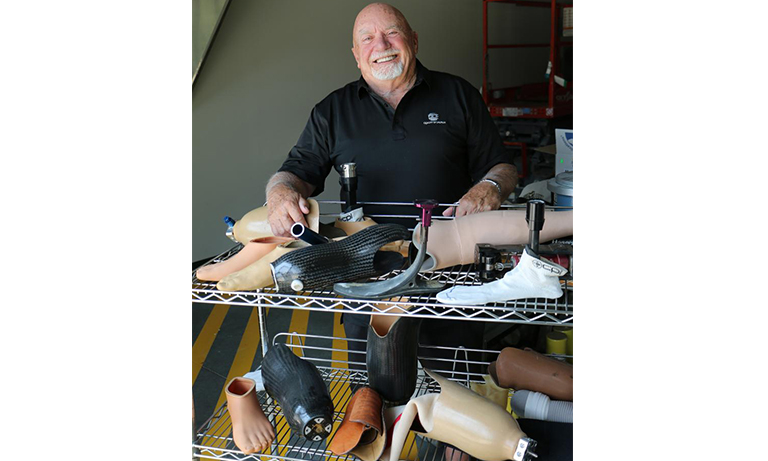In an empty classroom on the third floor of Building 192, Jon Monett sits in front of a camera, artificial light illuminating his face, as he clutches his script. After a final take – Monett improvising much of it — a filming crew wraps up and prepares for the next assignment.
“They’re making a 2-minute promo of the challengers of the class of 2019,” Monett explains.
That class will consist of 25 new individuals, including wounded veterans, who all have physical challenges they will ask students to address. Cal Poly will tackle the most challenges – up to eight – while the rest will go to other schools that have a Quality of Life Plus lab.
Monett, a Cal Poly graduate, established the QL+ program at his alma mater in 2009. He was inspired by the feature film “Fighting for Life,” a documentary about a soldier who tries to bounce back after losing a leg. Monett only planned on having one QL+ lab, but it has since spread to a dozen other schools: Virginia Tech, Colorado School of Mines, Universities of Dayton, Colorado, Ohio, and Cincinnati, VCU, George Mason, San Diego State, UCONN, UT San Antonio, and Xavier University.
Those with challenges are encouraged to solicit help from QL+ before each school year.
“We have challengers put together a video that says what their challenge is,” Monett said.

Past projects at Cal Poly have included a training fin for a trans tibial amputee who wanted to swim for resistance training, a chair lift for an injured Air Force vet and a lift for a marine missing legs at the hip.
Perhaps the best known challenge was provided by Taylor Morris, a Navy Explosive Ordinance vet who lost parts of all four limbs to an explosion while serving in Afghanistan. The lab garnered headlines when students created a “quick swap” that Morris could use to change prosthetics on his own.
The next year students continued to refine the device while addressing another Morris challenge: cooling the extended limbs, which frequently become very hot.
“That’s how you can tell the QL + program really cares,” Morris said. “They’re not just getting a photo opp.”
Challenges are directed toward Lily Laiho, the faculty advisor to the lab. After the challengers are narrowed down, students indicate their preference on which ones they want to pursue, and faculty ultimately decide where assignments go shortly after the fall quarter begins. The students will then work on the challenge for the entire school year.
For the challengers, it offers an opportunity to have students bring new ideas to their unique problem, and they are motivated to help the students become better engineers.
“The students come in with new approaches and these fresh ideas that haven’t been stomped out of them by working at a company for a long time,” Laiho said.
In turn, the QL+ program provides students an excellent opportunity to do hands-on work while making a difference in someone’s life.
“The whole point of this lab is to help people like Taylor that want to make the best of their situation,” said Greg Orekhov, who is wrapping up his master’s thesis as he begins work on a doctorate. “It’s very fulfilling to be able to help the quality of life for someone through engineering.”
That’s definitely a step up from Monett’s senior project – making production tools.
“The idea was, ‘Why don’t we give them something useful to do?’” said Monett, an ardent supporter of the university.
After graduating with an industrial engineering degree in 1964, Monett spent 26 years working for the CIA Office of Technical Services before launching Telemus Solutions, a global security consulting and intelligence advisory services company.
The lab at Cal Poly is currently being upgraded with new furniture, a workspace area and a new 3D printers But the challenges will continue as planned.
While wars in Iraq in Afghanistan resulted in droves of injured vets, there are still many new vet challenges, Monett said.
“We have a guy who had seven or eight deployments, came back and got hit by a drunk driver,” he said.
Even if wounded vets have been provided with prosthetics that allow them to walk, many want to do more, including amputees who want to do marathons and blind vets who want to kayak.
“A lot of these challenges are to continue to allow them to do the things they love,” Laiho said.


